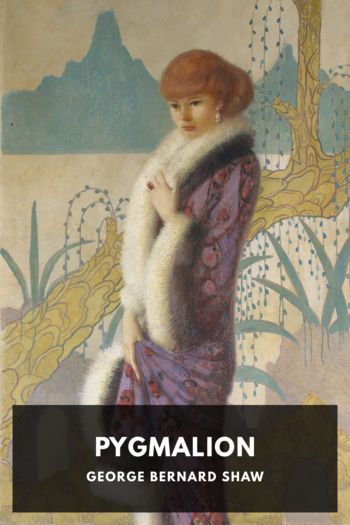Bulfinch’s Mythology Thomas Bulfinch (intellectual books to read TXT) 📖

- Author: Thomas Bulfinch
Book online «Bulfinch’s Mythology Thomas Bulfinch (intellectual books to read TXT) 📖». Author Thomas Bulfinch
As to Charlemagne, though his real merits were sufficient to secure his immortality, it was impossible that his holy wars against the Saracens should not become a favorite topic for fiction. Accordingly, the fabulous history of these wars was written, probably towards the close of the eleventh century, by a monk, who, thinking it would add dignity to his work to embellish it with a contemporary name, boldly ascribed it to Turpin, who was Archbishop of Rheims about the year 773.
These fabulous chronicles were for a while imprisoned in languages of local only or of professional access. Both Turpin and Geoffrey might indeed be read by ecclesiastics, the sole Latin scholars of those times, and Geoffrey’s British original would contribute to the gratification of Welshmen; but neither could become extensively popular till translated into some language of general and familiar use. The Anglo-Saxon was at that time used only by a conquered and enslaved nation; the Spanish and Italian languages were not yet formed; the Norman French alone was spoken and understood by the nobility in the greater part of Europe, and therefore was a proper vehicle for the new mode of composition.
That language was fashionable in England before the Conquest, and became, after that event, the only language used at the court of London. As the various conquests of the Normans, and the enthusiastic valor of that extraordinary people, had familiarized the minds of men with the most marvellous events, their poets eagerly seized the fabulous legends of Arthur and Charlemagne, translated them into the language of the day, and soon produced a variety of imitations. The adventures attributed to these monarchs, and to their distinguished warriors, together with those of many other traditionary or imaginary heroes, composed by degrees that formidable body of marvellous histories which, from the dialect in which the most ancient of them were written, were called “Romances.”
Metrical RomancesThe earliest form in which romances appear is that of a rude kind of verse. In this form it is supposed they were sung or recited at the feasts of princes and knights in their baronial halls. The following specimen of the language and style of Robert de Beauvais, who flourished in 1257, is from Sir Walter Scott’s Introduction to the Romance of Sir Tristrem:
“Ne voil pas emmi dire,
Ici diverse la matyere,
Entre ceus qui solent cunter,
E de le cunte Tristran parler.”
“I will not say too much about it,
So diverse is the matter,
Among those who are in the habit of telling
And relating the story of Tristran.”
This is a specimen of the language which was in use among the nobility of England, in the ages immediately after the Norman conquest. The following is a specimen of the English that existed at the same time, among the common people. Robert de Brunne, speaking of his Latin and French authorities, says:
“Als thai haf wryten and sayd
Haf I alle in myn Inglis layd,
In symple speche as I couthe,
That is lightest in manne’s mouthe.
Alle for the luf of symple men,
That strange Inglis cannot ken.”
The “strange Inglis” being the language of the previous specimen.
It was not till toward the end of the thirteenth century that the prose romances began to appear. These works generally began with disowning and discrediting the sources from which in reality they drew their sole information. As every romance was supposed to be a real history, the compilers of those in prose would have forfeited all credit if they had announced themselves as mere copyists of the minstrels. On the contrary, they usually state that, as the popular poems upon the matter in question contain many “lesings,” they had been induced to translate the real and true history of such or such a knight from the original Latin or Greek, or from the ancient British or Armorican authorities, which authorities existed only in their own assertion.
A specimen of the style of the prose romances may be found in the following extract from one of the most celebrated and latest of them, the Morte d’Arthur of Sir Thomas Mallory, of the date of 1485. From this work much of the contents of this volume has been drawn, with as close an adherence to the original style as was thought consistent with our plan of adapting our narrative to the taste of modern readers.
“It is notoyrly knowen thorugh the vnyuersal world that there been ix worthy and the best that ever were. That is to wete thre paynyms, three Jewes, and three crysten men. As for the paynyms, they were tofore the Incarnacyon of Cryst whiche were named, the fyrst Hector of Troye; the second Alysaunder the grete, and the thyrd Julyus Cezar, Emperour of Rome, of whome thystoryes ben wel kno and had. And as for the thre Jewes whyche also were tofore thyncarnacyon of our Lord, of whome the fyrst was Duc Josue, whyche brought the chyldren of Israhel into the londe of beheste; the second Dauyd, kyng of Jherusalem, and the thyrd Judas Machabeus; of these thre the byble reherceth al theyr noble hystoryes and actes. And sythe the sayd Incarnacyon haue ben the noble crysten men stalled and admytted thorugh the vnyuersal world to the nombre of the ix beste and worthy, of whome was fyrst the noble Arthur, whose noble actes I purpose to wryte in this person book here folowyng. The second was Charlemayn, or Charles the grete, of whome thystorye is had in many places both in frensshe and





Comments (0)